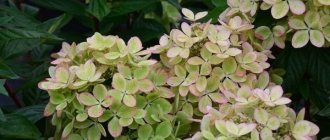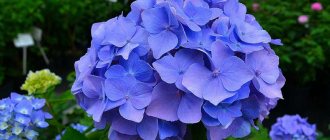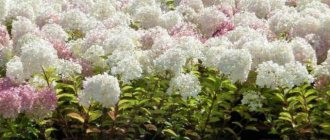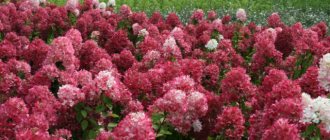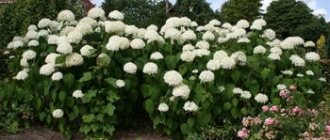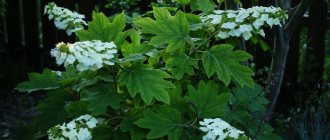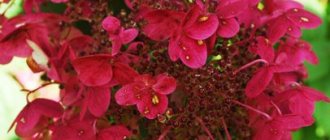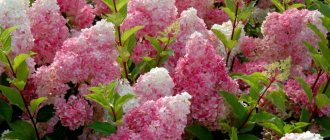Plants » Flowers
0
285
Article rating
Kira Stoletova
The Magical Candle hydrangea variety was created in 2007 under the patronage of the leading French company Sapho, which is engaged in the breeding and promotion of new ornamental garden plants. The breeding work was carried out directly by Dutch scientists from the Boot & Co Boomkwekerijen nursery, located in the Boskop community.
Hydrangea Magical Candle Description
Description of the variety
Magical Candle belongs to the subspecies of paniculate hydrangeas. International name: Hydrangea paniculata Magical Candle Bokraflame.
The variety is distinguished by its compact bush size, not exceeding 1.2-1.5 m in height and 1-1.2 m in width. The stems are strong, erect, with pubescent leaves of bright green color.
The indisputable advantage of the plant is its flowers. The huge porcelain-white flower heads appear to be illuminated from within, creating the illusion of a surreal soft glow in the sunlight. It is no coincidence that the name Magical Candle in translation sounds like “Magic Candle”.
The flowering period is standard: from July to the end of September.
White flowers with a pistachio-yellow core are grouped in large, very dense pyramidal panicles, reaching 30 cm or more. At the peak of their form they become snow-white. Closer to autumn, the petals begin to gradually turn pink, from the lower tiers to the top. At the end of flowering, they completely acquire reddish shades.
The inflorescences, despite their size, are held quite firmly on high vertical stems. The thick, lacy panicles of this variety are one of the most beautiful in its class.
What is needed for planting
Planting hydrangea has some peculiarities. First you need to prepare a hole 50 cm wide. The day before planting, fill it with water. After the moisture has completely disappeared, 20 cm of hydrangea soil containing peat, pine needles, soil from under deciduous trees, equal parts of humus and sand should be poured onto the bottom.
It is also necessary to apply fertilizers - 1 tbsp. a spoonful of potassium superphosphate and potassium sulfate. Do not add lime, chalk, or tree bark. These components will destroy the seedling.
The hydrangea bush, together with a lump of earth, is placed in a hole, filled with soil mixture and watered.
Note! To prevent moisture from evaporating, the tree trunk circle is mulched. Sawdust and finely chopped tree bark are suitable for this purpose.
Planting hydrangea
Choosing the optimal location
Magical Pinkerbell is a hydrangea that does not tolerate bright sunny colors. In an open place, its growth slows down, flowering is not abundant, and the inflorescences are large. For her, it is better to choose a semi-shaded area, protected from the wind. The soil should be moist, slightly acidic, but not swampy. The plant is resistant to low temperatures, but it is better to cover the bush with a synthetic cloth. If the shoots freeze, new ones will quickly grow from the roots.
Important! For hydrangea, it is better to prepare a support ladder, since the shoots do not always withstand heavy inflorescences
Step by step planting process
Planting hydrangeas is done as follows:
- A month before planting a new species, you need to choose a place, mark it and prepare a hole of suitable size.
- The hole needs to be watered and filled with soil mixture.
- The seedling is removed from the container and placed in the center of the hole.
- It is necessary to ensure that the root collar protrudes slightly from the ground, all the roots lie straightened and free.
- The soil is poured in a circle and lightly compacted.
- After the hole is almost filled, you should pour out a bucket of water, wait until it is absorbed and add soil to the edge of the hole.
All that remains is to mulch the soil, cover the plant from the sun and wind and water it periodically.
Landing
Hydrangea paniculata Magical Candle grows most productively in moist, well-drained, organic-rich, loose, acidic soils. It easily tolerates temporary waterlogging; on the contrary, it suffers from drought. It can grow on neutral soils, but will feel depressed on alkaline soils.
Magical Candle Hydrangea Description
You can acidify the area with moss collected from raised bogs or special fertilizers. Heavy clay soil without the addition of baking powder promotes root rot.
Deadlines
You can plant all year round.
- In winter, cuttings can be planted at home in flower pots.
- The best time for rooting in open ground is from mid-May to June.
- In autumn, you can plant until October, but no less than a month before frost.
Selecting a location
The Magical Candle variety loves light areas. However, an area open to the winds and sun is not the best option. Preference is given to a place that is well lit in the morning or evening, and protected from direct sunlight at midday. Preparation involves clearing weeds and debris.
Preparation of planting material
Healthy specimens are selected. The presence of diseases will be indicated by spots on the leaves, their discoloration, traces of mold and rotting of the roots.
When planting seedlings with an open root system, the roots are shortened and soaked for a couple of hours in a disinfectant solution. For example, potassium permanganate.
Technology
To plant hydrangeas, dig a hole twice as wide as the root ball and the same depth. Approximate dimensions: 40x40x40 or 50x50x50 cm. Before filling the soil, a drainage 10-15 cm thick of gravel, expanded clay, ceramic fragments or broken brick is laid at the bottom.
The excavated soil is mixed with compost and baking powder if the soil is heavy. If the soil is sandy or poor, add mineral fertilizers. The seedling is placed in the center of the hole, the roots are straightened and carefully covered with the prepared substrate.
The ground around the bush is watered with 1-2 buckets of water to settle the soil. If necessary, add new one and trample it down. At the very end, the root zone is mulched and watered again. Recently, the bark of coniferous trees has been used as mulch. It prevents the evaporation of moisture from the ground, disinfects and acidifies the soil.
Attention! The root collar should not be buried in the ground. The ideal position is at ground level or 5-10 mm above.
Hydrangea Magical Candle care
Hydrangea paniculata Magical Candle, like all varieties of this species, loves moisture. It must be watered regularly and abundantly, using at least 30 liters of liquid per bush. If the summer is hot and dry, then watering is carried out twice a week; if the climate is moderate, then once is enough. If you add substances to the soil that retain moisture, the frequency of watering can be reduced. The procedure is carried out in the early morning or when the sun becomes less active, that is, in the late afternoon. If you water the plant during the day, it may get burned. To keep moisture in the soil as long as possible, you need to cover it with a layer of mulch. This could be leaves, sawdust, pine needles or dry grass. It is important to loosen the soil, as this allows oxygen and nutrients to penetrate better and faster to the roots.
The most suitable time for feeding will be May-June, during the period of active growth of the bush. Organic and mineral fertilizers are best suited for feeding Magical Candle. This variety is suitable for natural nutritional components contained in compost, cow manure and bird droppings. Mineral-based fertilizers are selected based on the growth period. During the swelling of the buds, nitrogen-based fertilizers are suitable; before flowering begins, potassium and phosphorus should be used.
It is important to know that fertilizers are applied once every 2 months after watering, this is due to the sensitivity of the root system to fertilizing. We should not forget that an excess amount of nutrients can be just as harmful as a small amount. If you overdo it, you can lose flowering and only watch the bush grow.
One of the important measures for caring for a hydrangea bush is pruning. High density of the crown affects the appearance of harmful insects in it. Pruning is done before the buds begin to swell. All weak and damaged branches are completely cut off, the rest are 1/3, leaving three pairs of buds on the shoots.
All healthy parts removed can be used as planting material. When a hydrangea reaches eight years of age, it is pruned to the very base. Thanks to this, the plant will rejuvenate by releasing new shoots and continuing to bloom profusely, lushly and brightly. Pruning affects the development of a strong root system and ensures the growth of many inflorescences.
Growing rules
Hydrangea has strong immunity. She is unpretentious and steadfastly endures conditions that are unsuitable for her. However, in order for it to show itself in all its glory, you must adhere to some recommendations.
Hydrangea Magical Candle photo description
Watering mode
Magical Candle, like any hydrangea, loves water. However, the intensity of irrigation directly depends on the composition of the soil and the amount of precipitation. On well-drained loams with regular rainfall, additional watering should not be done. On sandy soils, moisture drains faster.
If the weather is dry, it is recommended to water the bush at least once a week with a volume of 30-40 liters.
Mulching will help conserve precious moisture. However, when distributing mulch, it is desirable that it does not cover the root collar. Drip irrigation gives the best results. It helps reduce the amount of water and can also be used for dosed liquid feeding.
Attention! Chlorine-rich, cold and hard water from the pipeline will not work.
Top dressing
- In the spring, at the beginning of growth, combine organic fertilizing with mineral complexes.
- During the budding period - phosphorus-potassium fertilizers.
- In July and August it is useful to feed with mullein infusion.
- In autumn, rotted manure or compost is used as mulch: 1-2 buckets per bush.
It is important to avoid excess nitrogen. It provokes the development of a disease such as chlorosis.
The intensity of fertilizing directly depends on the fertility of the soil. If there is already an abundance of organic matter, you can limit yourself to adding minerals and trace elements.
Description of the type of magical candle
Magical Candle is a popular variety of panicle hydrangea, perfectly adapted for growing in temperate climates.
Main characteristics of the species:
- The height of the bush is 1.5-2 meters;
- The height of the peduncles is 30 centimeters;
- The shape of the brushes is pyramidal;
- Flower color ranges from white to pink;
- The beginning of flowering is the first ten days of July;
- Flowering duration is two to three months.
Falling deciduous shrubs reach a height of one and a half to two meters with regular formative pruning. Profusely blooming mature three-meter specimens are often found.
The compact bush is formed due to the vertical orientation of the peduncles. The flowering phase begins in July and continues until the end of September or the onset of the first night frost. The plant forms dense pyramidal inflorescences up to 30 centimeters in height.
The color scheme of the inflorescences changes depending on the flowering time.
Initially, “magic candles” are painted in pale green, white, and light pink. Subsequently, the intensity of the pink range increases. As autumn approaches, the brushes are increasingly colored pink or dark pink with a pale top.
It has high frost resistance and does not require shelter. Tolerates drops in air temperature down to -29°C.
The species has gained wide popularity due to its compactness, hardiness and abundant flowering. Landscape designers use hydrangea magic candle to create ever-blooming gardens, hedges, and isolated plantings.
Features of care
During the flowering period
The variety stands out for its large inflorescences. Under favorable conditions, they grow so large that the stems may not withstand strong winds, especially after a rainstorm. Therefore, it is advisable to provide protection from the wind or strengthen the bush with supports and guy wires.
Magical candle
During the rest period
An important stage for the formation of a beautiful and healthy bush is pruning. Hydrangea paniculata blooms on young shoots of the new season, so it is better to do this in early spring - before the sap flows and the buds begin to swell.
Pre-winter pruning is allowed when the plant is already dormant - after it it is easier to cover the bush for the winter in areas with harsh winters.
First of all, thin, crooked, diseased and excess shoots are removed. The main skeletal woody branches are also cut to half, or even lower. Even if 15-30 cm “stumps” remain above the ground, Magical Candle will bloom in summer. Moreover, extreme pruning at intervals of 5-7 years is useful for rejuvenating the bush.
Preparing for wintering hydrangea medical candle
Hydrangeas should be prepared to correctly enter the dormant phase. Shrubs stop feeding with the onset of the first night frosts or the end of flowering. Watering is gradually reduced so as not to provoke the growth of new young shoots. Experienced gardeners remove two-thirds of the green foliage to more effectively prepare the plant for winter.
Breeders have adapted this variety of paniculata hydrangea to cultivation in temperate climates. Adult mature plants do not need winter insulation if winter frosts do not fall below -29°C.
It should be remembered that the frost resistance of hydrangeas directly depends on the age of the plant.
It is recommended to insulate one- or two-year-old seedlings that have not yet had time to form a powerful root system. The main measures for warming young bushes are aimed at preserving the roots. A mound of pine needles, crushed tree bark, fallen leaves or sawdust is poured around the plant.
Reproduction
Hydrangea can be propagated by seeds, layering, dividing the bush or root, or cuttings. Growing from seeds is the most labor-intensive method that does not guarantee results. It is mainly used by scientists for breeding work.
Hydrangea Magical Candle reviews
Reproduction by layering
The process takes 2 years, but gives a good result. In the first year, a side shoot during the growing season is bent to the ground, fixed and buried in the middle of the stem. By the end of autumn, roots will sprout in the buried part. In the second year in the spring, the stem is cut off from the mother bush and transplanted to a new place.
Cuttings
The most reliable method with an effectiveness of 95-99%:
- When the foliage has grown, cut off the upper part of the shoot 10-15 cm long.
- Tear off 1-2 pairs of lower leaves, keeping the upper ones.
- They are kept in “Kornevin” for a couple of hours.
- Plant in a fertile, loose substrate and water.
- They build a mini-greenhouse, which is regularly ventilated.
- Roots appear in 2-3 weeks.
Rules of care
Hydrangea Magical Candle is an unpretentious shrub, but it also requires basic care. Thanks to a little effort, it will delight you with its well-groomed and blooming appearance.
Magical Candle is a moisture-loving plant. The number of waterings and the volume of water should be adjusted depending on weather conditions. On average, watering is carried out 4-9 times per season at the rate of 3 or 4 buckets for each hydrangea.
The right time of day is morning or evening.
Tillage
After the watering procedure, it is recommended to loosen the soil and remove weeds. And to retain moisture and reduce the growth of weeds, the soil can be mulched with sawdust or peat.
Like almost all plants, hydrangea loves additional nutrition. To ensure abundant and long flowering, hydrangea needs to be fed:
- In early spring, add organic fertilizers (bird droppings or mullein) - this is necessary for fertilizing with nitrogen;
- In summer, when inflorescences form and bloom, fertilizers with phosphorus and potassium are usually used;
- For a comfortable wintering, hydrangea requires autumn fertilizing with mineral fertilizers.
In order for the hydrangea crown to be lush, the pruning procedure is important. It is carried out in early spring, before the process of sap flow begins. Approximately 10 strong developed branches are cut to 5 buds. In subsequent years, in order to rejuvenate the mature plant, all its shoots are cut to 7 cm in height.
At the end of the season, when the Magical Candle has finished blooming, it is worth cutting off the dry inflorescences. This must be done before the onset of cold weather.
Preparing for winter
Hydrangea Magical Candle is a very frost-resistant plant. It can tolerate frosts down to -25-29 o C. If in the growing region in winter the temperature does not drop below these temperatures, the bush does not need to be covered. But this only applies to adult specimens.
Young plants should be covered regardless of the cold weather. To do this, use mulch or spruce spruce branches.
Diseases and pests
Aphids and powdery mildew are considered dangerous for hydrangeas.
- Fungicides are used to treat and prevent fungal diseases such as powdery mildew. For the number of treatments and volume of the drug, see the instructions for use;
- Insecticides are used to control aphids. They easily cope with colonies of pests, aphids and more.
Diseases and pests
The plant rarely gets sick. If your immune system is weakened, some problems may arise.
| Disease | Treatment | Prevention |
| Leaf spot | Depends on the cause of the disease. For bacterial infections, bactericidal preparations are used; for fungal infections, fungicides are used. Or broad-spectrum (Bordeaux mixture). | Avoid thickening of plantings. In the spring, strengthen with immunomodulators. |
| Powdery mildew | A wide range of fungicides (“Baktofit”, Bordeaux mixture, “Chistotsvet”, “Topaz”, “Fitosparin”, copper sulfate). | Remove heaps of garbage and weeds in a timely manner. Do not allow the soil to become waterlogged. |
| Rust | Destroy affected shoots. Treat with Topaz, Baktofit or Bordeaux mixture. | When purchasing new plants, quarantine them. Monitor the area. Feed on time. |
Planting a flower
We recommend that you read
It is best to plant hydrangea in the spring, when the soil has already thawed and the buds have not yet begun to bloom.
Planting includes the following steps:
- 1The pit must have a depth of at least 40 cm, a diameter of about 50 cm. Depending on the size of the bush and the fertility of the soil, the dimensions of the pit may be smaller or larger. If the soil is not very fertile, you need to make the hole deeper. You need to fertilize with mineral fertilizer, and fill the hole with humus and peat.
- 2The planting material is dug out along with a lump of earth. Before planting, use pruning shears to remove broken branches and roots.
- 3When planting a bush, a hill is poured in the center of the planting hole, flush with the edges. Then the roots of the seedling need to be carefully distributed in different directions.
- 4During planting, the root neck may be slightly deepened, but only up to 3 cm. Otherwise, the plant will develop more slowly.
- 5The soil around the paniculate hydrangea is compacted and then watered well, directing a stream of water into the hole under the plant. All soil should be saturated with water.
These are the basic rules for planting Magical hydrangea. If you plant paniculate hydrangea correctly, then further care for it will not be difficult, and the bush itself will grow healthy and beautiful.
Landscape use
Hydrangea Magical Candle universal. It creates excellent mixborders in combination with other varieties of Hydrangeaceae, ornamental shrubs, low-growing coniferous trees, and tall cereals.
Hydrangea paniculata magic candle photo
The manufacturer recommends using Magical Flame, Everlasting Crimson, Bokrashine First Editions Shining weigela, and Elsdancer Tiny Dancer lilac as companion plants.
Hedges are often formed, both on private plots and in city parks. The plant tolerates urban microclimates well and is little susceptible to dust and high CO2 content.
The variety looks great in a single planting in the middle of the lawn, or in a tub on the terrace. Dried flowers demonstrate high decorative qualities - they will make long-lasting flower arrangements and ekibans.
Transplanting hydrangeas into open ground
Hydrangea Paniculata Magical Sweet Summer
It is best to plant in open ground in early spring, while the plant has not yet woken up after winter sleep. If there is a need to replant in the fall, this can be done after the garden beauty has shed its leaves in preparation for wintering.
To transplant Magical hydrangea, you need to have a special soil mixture that will nourish the plant and prevent the roots from rotting. The hole should be 2 times larger than the earthen ball with roots, so that the flower has the opportunity to develop in the process of growing green mass.
Hydrangea paniculata Magical should grow in a sunny area or in partial shade from taller trees or a fence. Absolute shadow will not suit her. It will not die from a lack of sunny color, but the quality of flowering may deteriorate: the appearance of the flowers will become pale and unattractive.
Hole for planting
Planting should be carried out taking into account a number of rules:
- Dig a hole in a sunny or partial shade location twice the size of the flower's earthen ball.
- Place drainage at the bottom of the hole. Broken brick or large expanded clay are perfect.
- Cover the plant's rhizome tightly with fertile soil mixture (humus, sand, fertile soil).
- Pack the soil well, paying particular attention to the area around the trunk.
- Water abundantly: a hole 50 cm deep and 50 cm in diameter will require at least 10 liters of water.
Reproduction methods
Planting chrysanthemums in open ground in spring
The most commonly used methods of propagating Magical hydrangea are cuttings and rooting layering.
By layering
It's easiest to use the second option. There is no need to separate part of the shoot, prepare a special substrate, or care for seedlings.
The process of obtaining a new plant goes like this:
- A shallow groove is pressed down next to the mother bush.
- One of the lower, healthy stems fits into it.
- In several places the shoot is pinned to the bottom of the groove.
- The entire cutting is covered with soil and watered.
During the summer, the cuttings will be watered and fed together with the mother plant. The top of the layer should protrude above the surface of the ground. Rooted bushes are not replanted until next spring. They should be covered for the winter.
Cuttings
The second easy option for propagating Hydrangea paniculata Magical Candle is cuttings.
Propagation by cuttings
Planting material can be buried under the bush. Before this, they should be treated with a root formation stimulator, Kornevin, Epin are suitable. Sections of branches up to 20 cm in length are deepened into the ground by 2 buds.
How to prepare Magical Candle for winter?
Shrubs stop fertilizing with the first night frosts or after flowering ends. It is necessary to gradually reduce watering. Otherwise, new shoots will begin to grow. It is recommended to remove two or three leaves. And if adult specimens tolerate low temperatures well, young seedlings are less resistant. Annual and biennial bushes do not yet have a well-developed root system, so it is the underground part that should be protected from frost. Pine needles, fallen leaves, sawdust or tree bark are sprinkled around the plant to “warm” the roots. Three-year-old and older plants do not need to carry out such an event and tolerate the winter well, since they are already growing a powerful underground part.
Choosing a site for planting and preparing the soil
Having purchased a seedling, you need to decide where to plant it so that it develops harmoniously and blooms with large caps of flowers. To begin with, it prefers nutritious soil with slight acidity. That is, if the gardener has sandy or chalky soil on the plot, then hydrangea will not grow on it. But this will also not be an obstacle to planting a seedling. It’s just that the size of the hole is dug deeper and wider, and nutritious black soil and peat are added there.
The place where the Magical panicle hydrangea variety will be planted should be slightly shady. The best solution would be if the shade from a fence or house protects it from the midday heat. When digging a hole near the house, you need to make sure that it is 150 cm from the wall. This will protect the bush in the spring from icicles falling from the roof of the house.
Hydrangea paniculata varieties for the Moscow region
It is not easy for residents of the Moscow region to choose an ornamental shrub for their garden that, despite the capricious nature of the region, would remain attractive and elegant every year until late autumn. A good choice in this case are varieties and hybrids of paniculata hydrangea, some of which were bred specifically for the conditions of the Moscow region.
Varietal cultivars are mostly bushes up to 1.5-3 m in height, characterized by increased winter hardiness, long flowering of lush inflorescences, and a wide variety of colors - from white to deep red. They tolerate air pollution very well, which is attractive for use as green fences. From the proposed varieties, you can select the ones you like best and use them for living fencing of the site, varieties with early flowering, varieties with special decorative properties to enhance the attractiveness of the lawn or the overall landscape of the site.
Grandiflora
Hydrangea paniculata Grandiflora
The most attractive variety, distinguished by large (up to 30 cm) wide-pyramidal inflorescences with changing colors of flower petals from snow-white to crimson. Blooms from July to September. A distinctive feature is high winter hardiness, rapid growth, low demands on the level of soil fertility. When grown in shaded areas, it does not lose its ability to bloom lushly, but prefers sunny areas. When dried, the color scheme of the inflorescences does not change and is used by florists to compose dry bouquets.
Vanilla Fraze
Hydrangea paniculata Vanilla Fraze
Deciduous shrub up to 2 m in height. In spring they are covered with snow-white pyramid-shaped inflorescences. Over time, the inflorescences change the color of the flowers to soft and intense pink. In the Moscow region it blooms from July to October. In winter it does not require shelter, which allows the variety to be used as a hedge.
Phantom
Hydrangea paniculata Phantom
Hydrangea paniculata Phantom
The variety of hydrangea paniculata is simply necessary in a summer cottage. It is distinguished not only by its attractive flowering, but also by its aroma with notes of honey. A special feature is high resistance to diseases in conditions of high humidity in the root system area. Perfectly tolerates cultivation on depleted soils. The pastel color of the inflorescences and long-term flowering, the possibility of forming in the form of a bush or low tree, is in high demand among the population and lovers of country holidays in the Moscow region.
Limelight
Hydrangea paniculata "Limelight"
The most successful variety for the conditions of the Moscow region. Blooms from July to September. Frost-resistant. Heavy from the abundance of flowers, 25-30 cm inflorescences, on early woody shoots do not require garter or supports. The shrub has an interesting property. When grown in the shade, the inflorescences have a greenish tint; in sunny areas they are snow-white.
polar bear
Hydrangea paniculata Polar Bear
The cultivar combines the properties of grandiflora and limelight. The 2 m tall shrub during the flowering period (from July to October) is covered with dense cone-shaped inflorescences. Does not require supports or garter. Throughout the entire growing season, the inflorescences remain highly decorative, gradually changing colors from snow-white to light pink.
Weems Red
Hydrangea paniculata Vims Red
Among the new products, residents of the Moscow region can be offered the Weems Red variety. Low shrubs up to 1.5-2.0 m in height. Depending on the type of soil (acidity level) and climate, they bloom with lush openwork caps of inflorescences, changing color from snow-white to dark and burgundy red. During the flowering period, the bush is literally covered with blooming inflorescences from the top to the ground. Blooms from June to October. It is recommended by landscapers for creating contrasting combined plantings in the decor of trimmed lawns, single bushes, hedges, and in group plantings with conifers. The variety is undemanding to light levels.
Kyushu
Hydrangea paniculata Kyushu
An old variety with a rounded dense crown. Early flowering. Densely hairy panicle inflorescences appear in June and bloom until October. Flowers lose their petals in a short period of time. Under the influence of warm weather, the bush grows in width and forms into a huge decorative ball. Easily tolerates frosty winters of the Moscow region. Acidified soil is ideal for growing. Tolerates clay soils, but prefers light soils. The brightness of flowering depends on the acidity level of the soil. When grown on soils of neutral acidity, the variety loses its decorative properties. Under conditions that meet the requirements, it can grow in one place for up to 60 years.
